Combine harvesters CLAAS
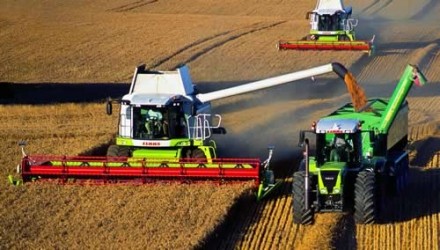
Claas machinery works in the fields around the world, is trusted and popular among farmers. A small family business form HarzevInkel (Germany) achieved success at international level, which has its production and sales companies in more than 100 countries. Knowing its customers and taking into account their wishes - became the key to success of the brand Claas.
Everything started from the straw trusser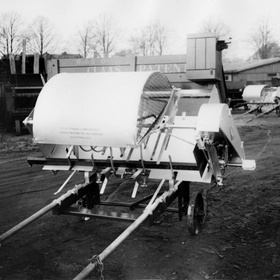
The history of the Claas company reaches deep into the past. For the period of its activity in structure and the organizational production of the company occured lots of transformations, changes with a clear tendency for improvement and expansion of influence areas.
Claas company was established in 1887 by Franz Klaas senior, as one that specializes in the production of dairy centrifuges. In 1913 machine repairman August Klaas is under his guidance the small company of his father - Franz Klaas. A year later, joining forces with his brothers Bernhard and Franz company operated under the sign of Gebr Claas - «Claas brothers». Klaas brothers were convinced of the possibility and necessity of combine production at European fields. Work on the combine prototype was launched in 1930. The success of the company came in 1936, when August Claas designed trailer, driven by the tractor combine with the side header - the first combine, designed to harvest in Europe and is made in Europe. It was a multi-functional machine - three-in-one - mowing + thresher + knitting machine, «Mah-Dresch-Binder» (MDB). In good conditions, using this combine the farmer could collect up to 30 tons of wheat per day. The following year, was launched serial production of combine harvesters MDB.
In 1953, Claas company put on the market first self-propelled combine, with its own engine. This scheme has taken root in agricultural industry very quickly. Over the next decades the company developed more powerful harvesters for all kinds of grain, all climatic conditions and for all fields of the world.
Family affair
 The case of four Klaas brothers August, Theo, Franz and Bernhard, who loved it and made their impact to its development, each year brought not only success in achieving their goals, but also international recognition. Each of them was marked with a peculiar trait of character, well remembered by workers. Thus, August Klaas got the name "seer" (he was ahead of his time, realizing that the agriculture of the future will require more complex solutions). Theo Klaas marked as a born diplomat (he managed to convince the British military authorities as Claas Super, saw to it, the company always has sufficient capital). Franz Klaas became the "Father of tool manufacture" (his goal - the actual production of tools and machines for Claas). Bernhard Klaas - man of extraordinary observation (he made the company better, not turning it upside down).
The case of four Klaas brothers August, Theo, Franz and Bernhard, who loved it and made their impact to its development, each year brought not only success in achieving their goals, but also international recognition. Each of them was marked with a peculiar trait of character, well remembered by workers. Thus, August Klaas got the name "seer" (he was ahead of his time, realizing that the agriculture of the future will require more complex solutions). Theo Klaas marked as a born diplomat (he managed to convince the British military authorities as Claas Super, saw to it, the company always has sufficient capital). Franz Klaas became the "Father of tool manufacture" (his goal - the actual production of tools and machines for Claas). Bernhard Klaas - man of extraordinary observation (he made the company better, not turning it upside down).
Own production, independent from suppliers and quality standards - principles Klaas borthers adhere.
Management of the company consistently passed along family line. In 1968 the company headed by Helmut Klaas - son of August Klaas, and in 2004 - Katrina Klaas - daughter of Helmut Klaas.
Stepping stages of development
 In 1966 the Claas company has changed its color - it has become green. Senator combine harvester was first released in a new design. From the technical point of view, it was observed in a new construction, which enabled Claas to become the first combine manufacturer in the world which combines with connecting power drive. Subsequently, appeared Mercator harvesters.
In 1966 the Claas company has changed its color - it has become green. Senator combine harvester was first released in a new design. From the technical point of view, it was observed in a new construction, which enabled Claas to become the first combine manufacturer in the world which combines with connecting power drive. Subsequently, appeared Mercator harvesters.
1967 - developed first baler with a floating piston - Claas Markant. By 2000, the Claas company released 130 thousand of such balers.
1969 - After the purchase of agricultural machine plant Josef Bautz, appear self-propelled foragers. A year later with the purchase of engineering plant Speiser of Heppinhen, product range of Claas products enlarged with mowers swathers, rakes and towing shredders (Volto, Liner, Disco, Cargos and Jaguar).
1970 - came the most successful series of large-scale combine harvesters Claas Dominator. This series lasted over 40 years. As part of the modernization Dominator improved with a straw walkers, 3-dimensional cleaning, Contur header, and later Auto Contur.
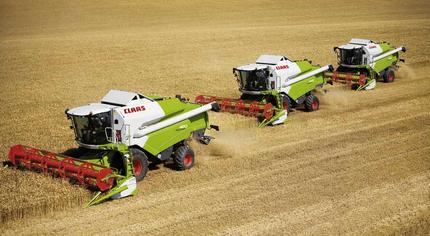 1976 - the company presented the first round baler Rollant 85. During the process were used steel rollers instead of stripes. Roller compaction system has become a benchmark for presses with a fixed camera and made Rollant leader on the Western European market.
1976 - the company presented the first round baler Rollant 85. During the process were used steel rollers instead of stripes. Roller compaction system has become a benchmark for presses with a fixed camera and made Rollant leader on the Western European market.
In 1981, at the market appeared combines with Dominator CS system cylinders. Soon, it was renamed to Commandor. In 1990 Commandor harvester set a world record in the UK: for 8 hours at has threshed 358 tons of wheat.
In 1992 Claas reveals combine harvesters production for harvesting rice in India. Geographically production and sales of Claas company covers more countries and continents: North and South America, Russia and India.
1995 - appeared new Lexion series with Hybrid system. Lexion was first among combine harvesters that use hybrid threshing and separation systems.
Combine harvesters
Currently, the series of Claas combines are marked with more modern equipment - Lexion, Tucano. However, this was not an obstacle to use older models of Mega and Dominator combines, who still work in the fields. Modern combines are high-tech and productive. Among the advantages of Claas combines can be mentioned:
- powerful propulsion and wide beater that allow cleaning of cultures with considerable speed;
- grain threshing system provides quality cleaning of grain;
- comfortable cabin with a large glazing area;
- speed, movement direction and position control of the header is caaried out by one multifunction joystick.
Claas сombines are self-propelled, multifunctional machines that mow and thresh grain, clean it, cut straw. High-performance series of combines are represented by Lexion, Tucano, Mega, Dominator.
Lexion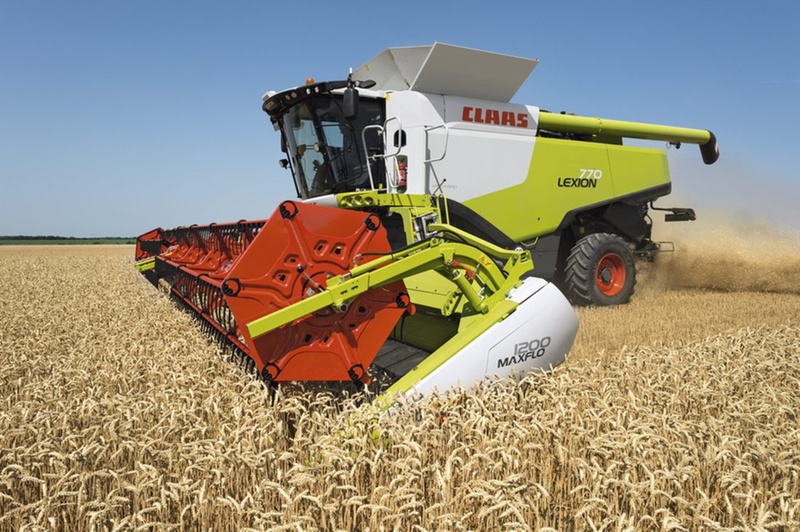
The line of combines Lexion is divided into two series - Lexion 700 series and 600 series. Each series includes several models. The specific feature of Lexion combine harvesters is unique grain threshing system APS. It provides work productivity by 20%. Electrohydraulic drive provides high speed of the combine. Driving wheels Lexion are made at crawler type drive, but as a tracks acts as a rubber band. Managed pneumatic tires were equipped pressure control system. 700 series consists of 750, 760, 770 and 780 models. They differ by a few parameters.
| Model | Lexion 740 | Lexion 750 | Lexion 760 | Lexion 770 |
| Years | 2010 | 2010 | 2010 | 2010 |
| Engine manufacturer | Mercedes Benz | Mercedes Benz | Mercedes Benz | Mercedes Benz |
| Engine capacity, L | 16 | 16 | 12.5 | 12.5 |
| Cylinders | V8 | V8 | 6 | 6 |
| Maximum engine power, hp | 431 | 466 | 530 | 586 |
| Fuel tank, L | 1150 | 1150 | 1150/950 | 800 |
| Gears | - | 2 | - | 2 |
| Speed min-max. km/h | 0-30 | 0-40 | 0-40 | 0-30 |
| Cutting width,m | 600, 660, 750, 900 | 600, 660 750, 900 | 600, 660 750, 900 | 600, 660, 750, 900 |
Claas Lexion combine of the newest version for 1 hour collects 100 tons of grain. Headers of modern machines have width of 12 meters. Combines differ by precision progress through the use of GPS, can carry up to 12,000 liters of grain, and their cost is about 500 000 euros.
Tucano
The line Tucano belongs to the premium segment of the middle class combines. They are structurally similar to the Lexion. Tucano includes two series - 580-570 and 450-320.
| Model | Tucano 320 | Tucano 330 | Tucano 340 | Tucano 430 | Tucano 440 | Tucano 450 |
| Years | 2007 | 2007 | 2007 | 2007 | 2007 | 2007 |
| Engine manufacturer | Mercedes-Benz | Mercedes-Benz | Mercedes-Benz | Mercedes-Benz | Mercedes-Benz | Mercedes-Benz |
| Engine capacity, cm3 | 6370 | 6370 | 6370 | 6370 | 6370 | 7200 |
| Cylinders | 6 TI | 6 TI | 6 TI | 6 TI | 6 TI | 6 TI |
| Maximum engine power, hp | 190 | 240 | 260 | 240 | 260 | 275 |
| Fuel tank, L | 500 | 500 | 500 | 500 | 500 | 600 |
| Gears | 3 | 3 | 3 | 3 | 3 | 3 |
| Speed min-max. km/h | 0-25 | 0-25 | 0-25 | 0-25 | 0-25 | 0-25 |
| Cutting width,m | 430 | 490 | 490 | 490 | 540 | 600 |
 Mega
Mega
The basis was taken Mega Dominator, but threshing system of Mega combine greatly improved. Models differ by manufacturers of power capacity, the total productivity (models 204, 208, 218, 350, 360 and 370).
| Model | Mega 360 | Mega 350 | Mega 370 |
| Years | 2003-2009 | 2003-2009 | 2003-2009 |
| Engine manufacturer | Daimler Chrysler | Daimler Chrysler | Daimler Chrysler |
| Engine capacity, cm3 | 6370 | 6370 | 6370 |
| Cylinders | 6 TI | 6 TI | 6 TI |
| Maximum engine power, hp | 220 | 240 | 260 |
| Fuel tank, L | 400 | 500 | 500 |
| Gears | 3 | 3 | 3 |
| Speed min-max. km/h | 0-24 | 0-24 | 0-24 |
| Cutting width,m | 450 | 510 | 600 |
 Dominator
Dominator
Le père des moissonneuses batteuses contemporaines Claas. On a installé le système de battage ordinaire mais avec 5 secoueurs de paille. La série a inclu les modèles de la petite classe et de la classe moyenne. Il y avait 10 modèles qui ont rapport à Dominator.
| Model | Dominator 130 | Dominator 140 | Dominator 150 |
| Years | 2004 | 2004 | 2004 |
| Engine manufacturer | Cat-Perkins | Cat-Perkins | Cat-Perkins |
| Engine capacity, cm3 | 5985 | 5985 | 5985 |
| Cylinders | 6 T | 6 T | 6 T |
| Maximum engine power, hp | 125 | 121 | 141 |
| Fuel tank, L | 200 | 280 | 280 |
| Gears | 3 | 3 | 3 |
| Speed min-max. km/h | 1,9-25 | 0-25 | 0-25 |
| Cutting width,m | 360 | 390 | 420 |
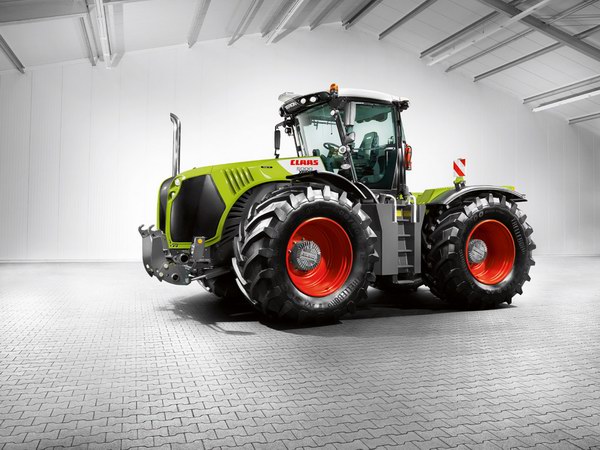 Tractors
Tractors
Popular among farmers were also Claas tractors. In 1993 was the first time powerful tractor Claas Xerion of their own development presented to the public. After buying a controlling interest of Renault Agriculture began a new round of traktor manufacturing. Family company Claas turns from cleaning equipment manufacturer to complex provider. October 1, 2003 at the French plant in Le Mans came out first green tractor.
In 10 years of activity in this direction appared first compact machine Nexos, universal Elios and Axos, tractors of middle class Arion, higher class - Axion, elite - Xerion.
Nexos, a vineyard tractor is more suitable for use primarily in viticulture and horticulture. Elios with a capacity of 72-88 hp has a small turning radius and the low center of gravity. Axos, whose power reaches 100 hp, suitable for work in the field and meadow. Arion (with four or six cylinders) are stronger - from 95 to 175 hp. Axion - big tractor with a power to 400 hp.
Quality products - satisfied customer
Today, many years after the invention of the combine, Claas is the leader of its sector in Europe and ahead of the competition. Approximately every third combine harvester sold on the continent is made by Claas.
Every year the company gets more and more international significance, confirmation of this - the emergence of new companies, factories around the world. Provide farmers with high-quality agricultural machinery that would give the possibility to evolve and keep up with the times - the main purpose of Claas.

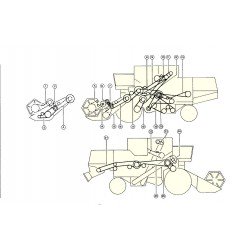
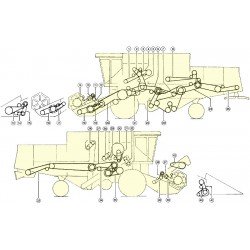
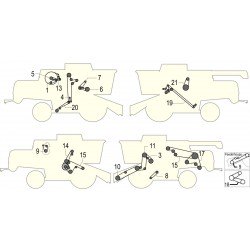
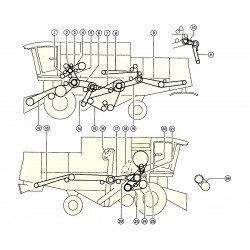


![Roller chain 31 links - 211234 suitable for Claas [Rollon]](https://agrodoctor.eu/96118-small_extra/xroller-chain-31-links-211234-suitable-for-claas-rollon-.jpg.pagespeed.ic._q3LkfwhUL.jpg)
![Roller chain 42 links - 211979 suitable for Claas [Rollon]](https://agrodoctor.eu/96069-small_extra/xroller-chain-42-links-211979-suitable-for-claas-rollon-.jpg.pagespeed.ic.jUXnaVuOtz.jpg)
![Roller chain 55 links - 211560 suitable for Claas [Rollon]](https://agrodoctor.eu/96071-small_extra/xroller-chain-55-links-211560-suitable-for-claas-rollon-.jpg.pagespeed.ic.jUXnaVuOtz.jpg)
![Roller chain 57 links - 212586 suitable for Claas [Rollon]](https://agrodoctor.eu/96054-small_extra/xroller-chain-57-links-212586-suitable-for-claas-rollon-.jpg.pagespeed.ic.eGMuCnPSET.jpg)
